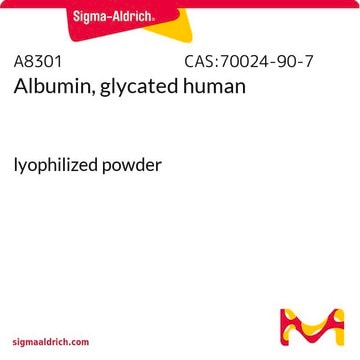The stability of this product in solution has not been evaluated. Generally, peptides should not be stored in solution for extended periods. Should solution storage be necessary, storing aliquots at -20°C is suggested. Note that peptides have a tendency to stick to plastic containers upon storage.
G9145
[Leu15]-gastrine I humaine
≥95% (HPLC)
Synonyme(s) :
[Leu15]-HG-17, Heptadécapeptide [leucine15]-gastrine I humain, Heptadécapeptide [leucine15]-gastrine I, LHG-17, [Acide 18-pyroglutamique, 32-leucine]-grande gastrine I-(18-34)-peptide amide, humain, [Leu15]-gastrine I humaine, [Leucine15]-petite gastrine I
Sélectionner une taille de conditionnement
Sélectionner une taille de conditionnement
About This Item
Produits recommandés
Source biologique
human
Niveau de qualité
Essai
≥95% (HPLC)
Forme
powder
Technique(s)
cell culture | mammalian: suitable
Numéro d'accès UniProt
Température de stockage
−20°C
Chaîne SMILES
CC(C)CC(NC(=O)C(Cc1c[nH]c2ccccc12)NC(=O)C3CCCN3C(=O)CNC(=O)C4CCC(=O)N4)C(=O)NC(CCC(O)=O)C(=O)NC(CCC(O)=O)C(=O)NC(CCC(O)=O)C(=O)NC(CCC(O)=O)C(=O)NC(CCC(O)=O)C(=O)NC(C)C(=O)NC(Cc5ccc(O)cc5)C(=O)NCC(=O)NC(Cc6c[nH]c7ccccc67)C(=O)NC(CC(C)C)C(=O)NC(CC(O)=O)C(=O)NC(Cc8ccccc8)C(N)=O
InChI
1S/C98H126N20O31/c1-49(2)38-68(115-96(147)72(43-55-46-101-60-19-12-10-17-58(55)60)117-98(149)74-20-13-37-118(74)77(122)48-103-86(137)61-25-31-75(120)105-61)93(144)111-66(30-36-82(131)132)92(143)110-65(29-35-81(129)130)91(142)109-64(28-34-80(127)128)90(141)108-63(27-33-79(125)126)89(140)107-62(26-32-78(123)124)88(139)104-51(5)85(136)113-70(41-53-21-23-56(119)24-22-53)87(138)102-47-76(121)106-71(42-54-45-100-59-18-11-9-16-57(54)59)95(146)114-69(39-50(3)4)94(145)116-73(44-83(133)134)97(148)112-67(84(99)135)40-52-14-7-6-8-15-52/h6-12,14-19,21-24,45-46,49-51,61-74,100-101,119H,13,20,25-44,47-48H2,1-5H3,(H2,99,135)(H,102,138)(H,103,137)(H,104,139)(H,105,120)(H,106,121)(H,107,140)(H,108,141)(H,109,142)(H,110,143)(H,111,144)(H,112,148)(H,113,136)(H,114,146)(H,115,147)(H,116,145)(H,117,149)(H,123,124)(H,125,126)(H,127,128)(H,129,130)(H,131,132)(H,133,134)
Clé InChI
CMVMLPDUAGUTOC-UHFFFAOYSA-N
Informations sur le gène
human ... GAST(2520)
Vous recherchez des produits similaires ? Visite Guide de comparaison des produits
Amino Acid Sequence
Description générale
Application
Actions biochimiques/physiologiques
Autres remarques
Code de la classe de stockage
11 - Combustible Solids
Classe de danger pour l'eau (WGK)
WGK 3
Point d'éclair (°F)
Not applicable
Point d'éclair (°C)
Not applicable
Équipement de protection individuelle
Eyeshields, Gloves, type N95 (US)
Faites votre choix parmi les versions les plus récentes :
Certificats d'analyse (COA)
Vous ne trouvez pas la bonne version ?
Si vous avez besoin d'une version particulière, vous pouvez rechercher un certificat spécifique par le numéro de lot.
Déjà en possession de ce produit ?
Retrouvez la documentation relative aux produits que vous avez récemment achetés dans la Bibliothèque de documents.
Les clients ont également consulté
Articles
Human pancreatic cancer organoid biobank (PDAC organoids) with various KRAS mutations to aide in 3D cell culture and cancer research applications.
-
After preparing aliquots, what is the stability of this product at -20?
1 answer-
Helpful?
-
-
Is this product also suitable for use with other mammalian species, such as mouse, for ex vivo tissue studies, as opposed to just human organoid culture medium?
1 answer-
The product's validation for batch release does not currently cover murine ex vivo tissue testing. However, the following citations may provide insights into its application for ex vivo non-human samples:
Sci Adv. 2023 Nov 17;9(46):eadh0322. Title: Inactivation of the tumor suppressor gene Apc synergizes with H. pylori to induce DNA damage in murine gastric stem and progenitor cells PMID: 37967175
Infect Immun. 2016 Sep 19;84(10):3083-91. Title: Intestinal Enteroids Model Guanylate Cyclase C-Dependent Secretion Induced by Heat-Stable Enterotoxins PMID: 27481254
Helpful?
-
-
I am interested in this product. A colleague uses it for human organoid culture medium. However, I work with murine ex vivo tissues. Is this also applicable for other mammalian species (so mouse in stead of human)?
1 answer-
This product has not been tested for use with murine ex vivo tissue. However, the following citations may be of interest for its application in ex vivo non-human samples.
Sci Adv. 2023 Nov 17;9(46):eadh0322.
Inactivation of the tumor suppressor gene Apc synergizes with H. pylori to induce DNA damage in murine gastric stem and progenitor cells
PMID: 37967175
https://pubmed.ncbi.nlm.nih.gov/37967175/Infect Immun. 2016 Sep 19;84(10):3083-91.
Intestinal Enteroids Model Guanylate Cyclase C-Dependent Secretion Induced by Heat-Stable Enterotoxins
PMID: 27481254
https://pubmed.ncbi.nlm.nih.gov/27481254/Helpful?
-
-
この製品の溶媒は何を用いればよろしいでしょうか。水またはPBS(-)には溶けますでしょうか、あるいはDMSOでしょうか。
1 answer-
This product is tested for solubility at 1mg/ml in 0.1% NaOH or 1% NH4OH. Other solvents have not been evaluated.
Helpful?
-
Active Filters
Notre équipe de scientifiques dispose d'une expérience dans tous les secteurs de la recherche, notamment en sciences de la vie, science des matériaux, synthèse chimique, chromatographie, analyse et dans de nombreux autres domaines..
Contacter notre Service technique








![[Leu15,Gly18]-Gastrin2-17](/deepweb/assets/sigmaaldrich/product/images/384/185/d3095ca6-fe9a-4e1c-b2e9-29ad2bd40c46/640/d3095ca6-fe9a-4e1c-b2e9-29ad2bd40c46.jpg)
![[Gly18]-Gastrin 1-17 human](/deepweb/assets/sigmaaldrich/product/images/973/112/79e0734e-033a-4a31-9368-b08610cdcfd1/640/79e0734e-033a-4a31-9368-b08610cdcfd1.jpg)




